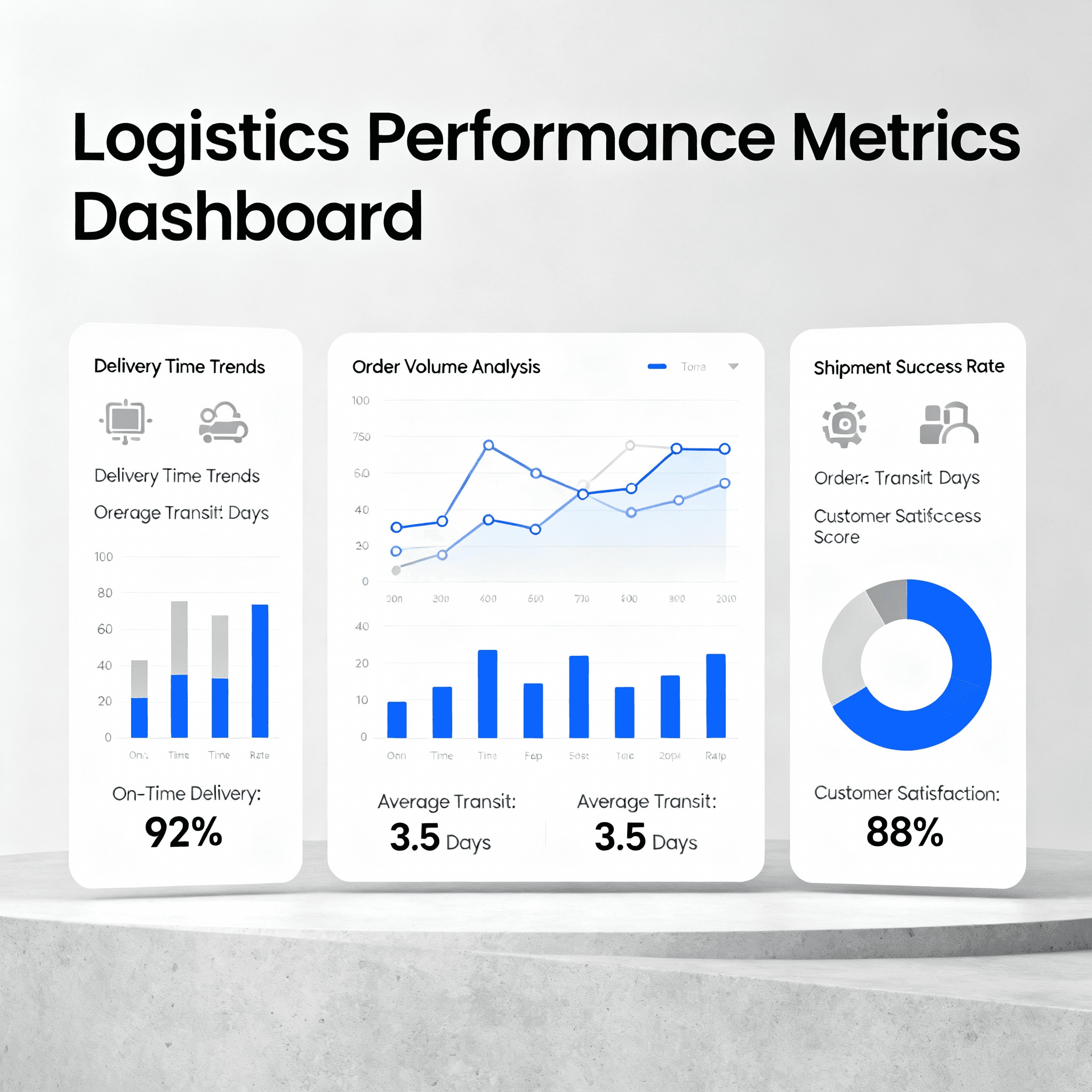What Key Performance Indicators (KPIs) Are Used to Measure the Success of AI in Logistics?
Saturday, 4 Oct 2025
|
The logistics industry is experiencing a paradigm shift thanks to the integration of Artificial Intelligence (AI) into daily operations. From route optimization to predictive maintenance, AI is helping companies streamline processes, reduce costs, and provide superior customer service. But how do logistics businesses measure the effectiveness of their AI systems?
Key Performance Indicators (KPIs) are essential for tracking the success of AI in logistics. These KPIs help executives, especially CEOs, CXOs, and COOs, evaluate AI's impact on operations and overall performance. Here’s a deep dive into the most crucial KPIs used to measure AI success in logistics.
1. Delivery Time Optimization
Why It Matters:
One of the primary goals of AI in logistics is to reduce delivery times. AI systems, particularly those powered by machine learning (ML), are capable of optimizing routes and delivery schedules in real time. By measuring the reduction in delivery time, companies can directly gauge AI's impact on their operations.
How It Works:
AI analyzes data from various sources, including traffic patterns, weather forecasts, and real-time vehicle information, to suggest the fastest, most efficient routes. Over time, this leads to improved delivery times, reduced fuel costs, and better customer satisfaction.
Real-World Example:
Companies like UPS and FedEx have used AI to optimize delivery routes, leading to significant improvements in their delivery efficiency. UPS reports saving millions of dollars in fuel costs annually thanks to their AI-powered ORION (On-Road Integrated Optimization and Navigation) system.
2. Inventory Turnover Rate
Why It Matters:
Efficient inventory management is critical for any logistics operation. AI helps optimize inventory turnover by forecasting demand, ensuring that stock levels are balanced to avoid both overstocking and stockouts. Monitoring inventory turnover rate allows logistics companies to understand how effectively their AI systems are managing stock levels and reducing excess inventory.
How It Works:
AI uses historical sales data and market trends to predict demand, helping businesses adjust stock levels in real time. This reduces waste and frees up capital tied up in unsold goods, improving cash flow.
Real-World Example:
Amazon leverages AI to maintain a highly optimized inventory system, reducing stockouts and overstocking issues. Their predictive analytics have allowed them to manage one of the largest and most complex inventories in the world with minimal human intervention.
3. Cost per Shipment
Why It Matters:
Reducing the cost of shipping while maintaining service quality is a critical goal for logistics companies. AI can help drive cost reductions by automating several aspects of the shipping process, from route planning to cargo load optimization.
How It Works:
AI analyzes past shipment data to optimize both transportation and warehousing costs. By predicting potential issues such as delays or increased traffic, AI systems can help businesses make better decisions to cut unnecessary costs.
Real-World Example:
DHL employs AI to manage its global supply chain, leveraging predictive analytics to optimize shipping costs. By reducing the number of unnecessary shipments and optimizing delivery routes, they’ve been able to significantly lower costs while improving service.
4. Customer Satisfaction and Retention Rate
Why It Matters:
Customer satisfaction is a cornerstone of any business, and AI in logistics plays a crucial role in improving this metric. AI enhances customer service by providing real-time updates on deliveries, offering predictive insights, and streamlining the resolution of issues such as delays or damaged goods.
How It Works:
AI-powered chatbots and virtual assistants enable logistics companies to handle customer queries in real time, reducing wait times and improving response accuracy. By measuring customer satisfaction, companies can determine if AI is enhancing the overall customer experience.
Real-World Example:
Maersk, one of the world’s leading container shipping companies, uses AI to offer customers proactive notifications and real-time tracking, significantly improving their customer satisfaction scores.
5. Operational Efficiency and Labor Cost Savings
Why It Matters:
AI is particularly effective at automating repetitive tasks, reducing the need for manual labor. By measuring the reduction in labor costs and improvements in operational efficiency, logistics companies can determine the financial impact of AI adoption.
How It Works:
AI-driven systems, such as robotic process automation (RPA) and AI-powered inventory management, can automate tasks such as sorting, packing, and data entry, reducing the need for human intervention. This results in cost savings, reduced human error, and more streamlined operations.
Real-World Example:
FedEx uses AI to automate various aspects of its operations, including package sorting and route planning, resulting in significant labor cost savings and improved overall efficiency.
6. Predictive Maintenance Success Rate
Why It Matters:
Downtime due to equipment failure is one of the largest costs in logistics. Predictive maintenance, powered by AI, is a solution that helps prevent costly breakdowns and extends the lifespan of assets such as trucks, warehouses, and conveyor belts.
How It Works:
AI systems analyze data from equipment sensors to predict when maintenance is needed, preventing unexpected breakdowns and reducing repair costs. By monitoring the success rate of predictive maintenance, companies can assess the impact of AI on reducing downtime and repair expenses.
Real-World Example:
UPS employs AI to predict when its vehicles will need maintenance, ensuring that their fleet is always in optimal condition and minimizing unexpected repairs.
7. Freight Volume and Capacity Utilization
Why It Matters:
Efficient freight management is essential to reducing costs and maximizing profits. AI helps logistics companies optimize freight volume by calculating the most efficient load sizes and identifying the best ways to utilize capacity.
How It Works:
AI-powered systems consider factors such as freight type, delivery time, and vehicle capacity to suggest the best way to load and transport goods. This helps logistics companies reduce empty miles and increase the efficiency of their fleet.
Real-World Example:
XPO Logistics uses AI for load optimization, ensuring that their trucks are operating at maximum capacity. This reduces wasted space, improves delivery times, and lowers fuel consumption.
8. Real-Time Data Insights and Reporting Accuracy
Why It Matters:
AI can provide logistics companies with real-time data insights, helping them make informed decisions and monitor their KPIs more accurately. By measuring how effectively AI tools provide actionable insights, companies can assess their overall performance and identify areas for improvement.
How It Works:
AI tools integrate data from multiple sources—such as GPS tracking, warehouse systems, and customer service platforms—to deliver real-time reporting dashboards. These insights allow managers to monitor key metrics like delivery times, cost per shipment, and fleet utilization in real time.
Real-World Example:
C.H. Robinson uses AI to consolidate data from various parts of their supply chain, providing detailed analytics that help them make quicker and more accurate decisions.
Conclusion: Measuring AI's Impact in Logistics
AI’s role in logistics is more than just a trend—it’s a business necessity. By tracking the right KPIs, logistics companies can measure the success of their AI-driven initiatives and make data-backed decisions that drive efficiency, reduce costs, and improve customer satisfaction. Whether it’s optimizing delivery routes, predicting maintenance needs, or improving customer service, AI provides the insights and tools that modern logistics companies need to remain competitive in an increasingly digital world.
Ready to Unlock the Power of AI in Your Logistics Operations?
Curious to see how AI can optimize your logistics operations and improve your KPIs? Book a Demo with Debales AI and let us show you how our solutions can drive measurable results for your business.
For more insights into AI’s transformative impact on logistics, check out our previous blog posts on How Predictive Analytics Works for Logistics and What Is a Digital Twin and How Is It Used in Logistics AI?.
All blog posts
View All →
Friday, 28 Nov 2025
The 90-Day Roadmap: Moving from Ad-Hoc AI to Operational Excellence
Stuck in AI experimentation? Learn how to escape Level 2 maturity using the Mess-O-Meter to diagnose chaos, prioritize with triangulation, and scale in 90 days.

Thursday, 27 Nov 2025
Mess-O-Meter Deep Dive: Real Logistics Examples for Digital Maturity
Discover Mess-O-Meter examples diagnosing digital chaos in logistics—baseline workflows, benchmark maturity, create AI roadmaps with real steps for transformation success.

Wednesday, 26 Nov 2025
Multi-Agent AI via Email: End-to-End Automation for Logistics Complexity
Explore agentic orchestration where autonomous email AI agents coordinate freight, customs, insurance, and carriers—automating multi-party processes for resilient supply chains.